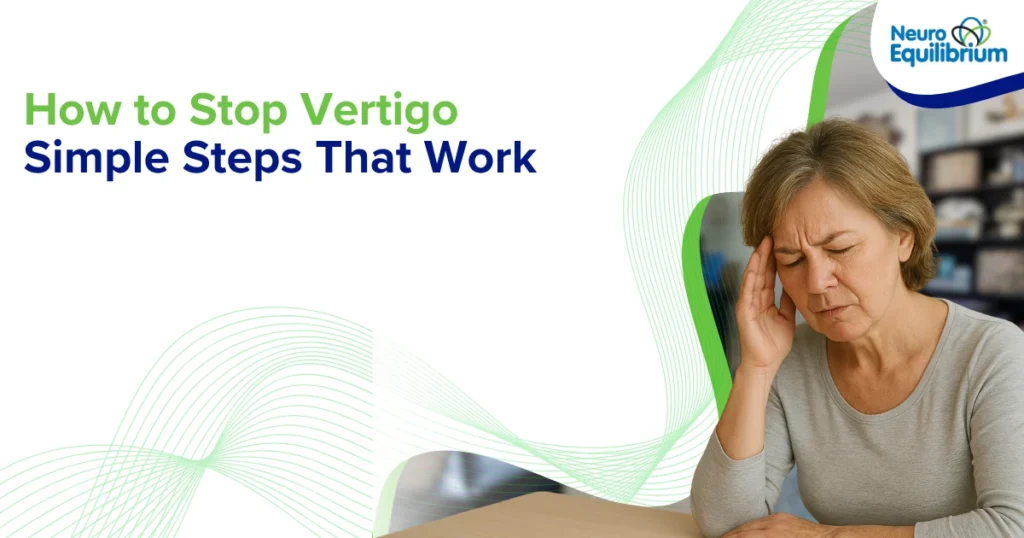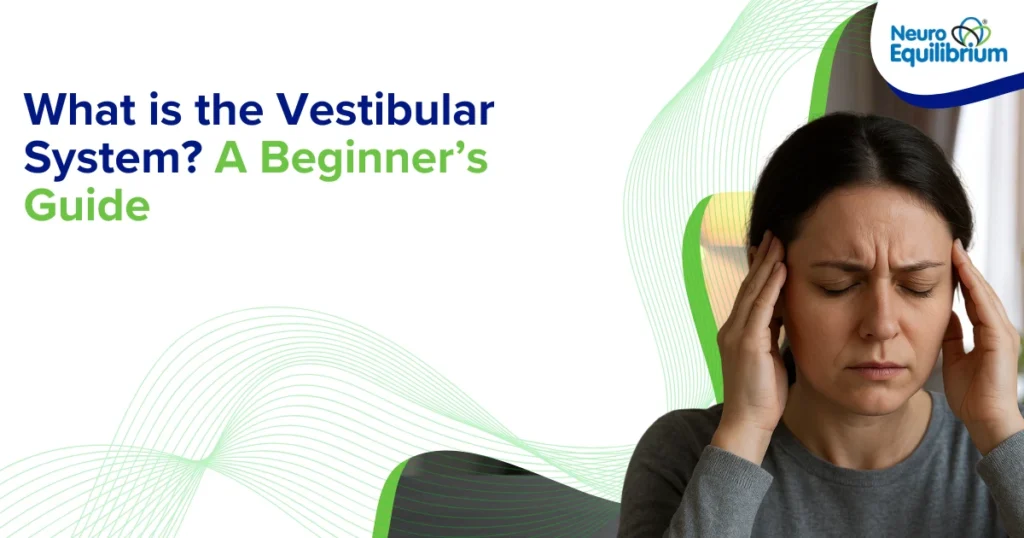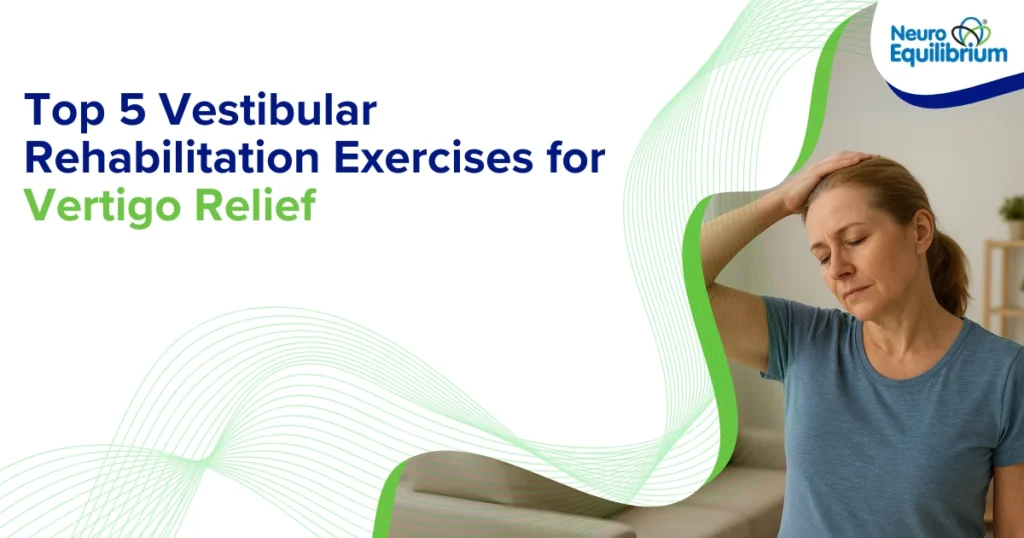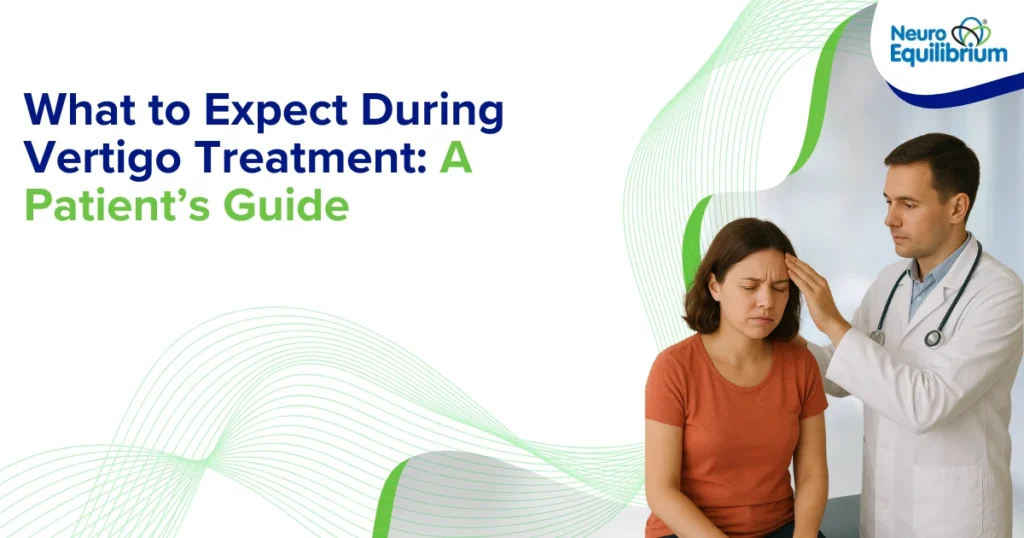That sensation of spinning or tilting of the world, even when you are still, can disrupt the simple day-to-day activities and create the fear of movement or falls. The positive thing is that a majority of vertigo disorders are fully curable as long as the right cause is determined.
More than 40 conditions may cause vertigo, which involves the balance system in the inner ear, the brain, or the body. It is for this reason that the first step of preventing vertigo is to get the right diagnosis. Home remedies or temporary relief through taking of tablets can help in the short run but will not allow the body or the brain to heal itself.
Immediate Actions During a Vertigo Episode
Your first objective must be to be safe. Imbalance may occur as a result of vertigo and leads to the likelihood of falling or getting injured. Prompt actions will assist you in keeping safe and mellowing the symptoms.
- Sit or lie down immediately: Get a secure and stable position to sit down or lie flat until the spinning is over. Do not stand or walk until you are straight.
- Remain calm: Feeling anxious and dizzy can be tough. Take deep, slow breaths and try to stay as still as possible. Remember, you’re doing your best, and this will pass soon.
- Don’t move suddenly: See to it that you do not jerk your head or body. The balance system is not overstimulated because of small and controlled movements.
- Rest and hydrate: Take a glass of water and lie down in a comfortable manner. The symptoms can be aggravated by dehydration and exhaustion.
When the spinning or dizziness fails to clear in a matter of a few minutes or recurs, then it is advisable to seek the help of a vertigo specialist as opposed to self-treatment.
Know More About Vertigo
- Why Do You Feel Unsteady on Your Feet?
- Is It Just a Migraine or Something More?
- What Is Ear Balance Treatment and When Do You Need It?
Targeted Medical Treatments
The best solution to prevent vertigo is all about its root cause that could only be determined with help of a specialist assessment. At NeuroEquilibrium Clinics, our physicians assist in identifying the cause of dizziness, be it of the inner ear, nerve, or brain and develop a treatment plan that will best suit you by using an elaborate Vertigo Profile Test.
A. Repositioning Maneuvers (For BPPV)
Benign Paroxysmal Positional Vertigo (BPPV) is the most prevalent cause of vertigo. It is a condition that arises when small crystals of calcium in the inner ear (also known as otoliths) get displaced and enter places where they are not supposed to be. This disfigures the balance sensors and causes a spinning sensation, particularly when you turn your head or switch positions.
A repositioning maneuver, the particular series of movements of the head and body, is the primary injury in the treatment of BPPV, aiming to move the crystals back to their usual position.
- Mechanism: This is how it works: These maneuvers, with the help of gravity and specific angles, are used to direct the loose crystals back into the utricle, the portion of the ear where they belong.
- Effectiveness: When done properly, these maneuvers have an immediate relief potential and the success rate of such maneuvers can be as high as 90 percent.
- Types of maneuvers:
- Epley’s Maneuver and Semont’s Maneuver are used for the most common type, Posterior Canal BPPV.
- Barbeque (Roll) Maneuver and Zuma Maneuver are used for Horizontal Canal BPPV.
- Why professional help matters: Due to the occurrence of 14 types of BPPV, the appropriate manoeuvre has to be selected depending on the eye movement pattern (nystagmus) during the examination. The possibility of worsening the symptoms with practicing the wrong maneuver is the reason that it is necessary to be guided by a trained specialist.
At NeuroEquilibrium Clinics, doctors perform these procedures using 3D guidance systems to ensure precise positioning. Most patients experience noticeable improvement after just one session.
B. Vestibular Rehabilitation Therapy (VRT)
Vestibular Rehabilitation Therapy is a highly effective program of exercises designed to help your brain adapt and improve your sense of balance. It gently trains your body’s coordination systems to address inner ear issues or imbalances, a process known as vestibular rehabilitation compensation.
The therapy plays a crucial role in the patients who are getting back to their normal functioning following an incidence of Vestibular Neuritis, persistent dizziness, or residual unsteadiness following BPPV treatment.
Goals of VRT:
- Reduce dizziness and improve overall stability
- Strengthen coordination between the eyes, brain, and body
- Build confidence in walking, turning, and daily movements
Key exercises include:
- Gaze stabilization: With slight side-to-side head movement, it is possible to refocus the eye on a fixed object and coordinate eye and balance movements with the use of eye movements ( Vestibulo-Ocular Reflex or VOR ).
- Balance training: Diligent training with safe standing, walking and controlled posture movements on diverse surfaces.
- Habituation exercises: Over time exposing the body to the movements that cause mild cases of dizziness and allowing the body to become accustomed to them and lessen them as time progresses.
VR technology is used at the NeuroEquilibrium Clinics to create a more engaging therapy experience. Patients can perform exercises on imaginary streets or moving platforms, making the environment feel very real and immersive. This modern approach not only speeds up healing but also helps patients regain their normal activities sooner. Additionally, the NeuroEquilibrium app offers guidance for patients to continue exercises at home, ensuring consistent support and progress.
C. Medications
Medication also has the short-term effects to control symptoms, but It should only be considered if prescribed by the doctor and it’s not to be substituted with diagnosis or therapy. Medical treatment aims at the control of nausea, dizziness, or inflammation and management of the underlying condition in other ways.
- Vestibular suppressants: Vestibular drugs: Vestibular drugs include meclizine or diazepam and should only be used in the short term (a few days). The long-term use would hinder the spontaneous recovery of the brain.
- Steroids: Short round courses of steroids are useful in Vestibular Neuritis or Labyrinthitis to decrease nerve inflammation and accelerate the healing process.
- Meniere disease: A nausea-inducing disorder linked to fluid in the middle ear that is treated with diuretics and low-salt diet.
- Vestibular migraine: Treated using migraine-prevention drugs and lifestyle modifications including regular sleep, hydration, and elimination of triggers.
The specialist of your NeuroEquilibrium will define the necessity of medication and the duration of its use, which will be the most effective and safe strategy to use to recover.
D. Psychological Support (CBT)
Vertigo can cause anxiety, fear of movement, or emotional stress, especially when episodes are frequent or unpredictable. Over time, this anxiety can worsen dizziness and delay recovery.
Cognitive Behavioral Therapy (CBT) is a powerful psychological therapy that can assist the patient in coping with such emotional impacts.
- How it works: CBT assists patients to counter negative thinking and decrease the fear of dizziness.
- Relaxation measures: Breathing and mindfulness will ease stress and relax the nervous system.
- Exposure therapy: Introduces movements or environments that cause dizziness gradually and safely in a controlled, safe environment which allows the brain to adapt.
CBT is frequently used alongside VRT at NeuroEquilibrium Clinics as a treatment of patients with Persistent Postural-Perceptual Dizziness (PPPD) or anxiety-related imbalance. The majority of patients observe that they are improving well in four to six weeks of regular sessions.
Lifestyle and Dietary Steps to Manage Vertigo
Lifestyle plays an important role in preventing vertigo episodes and maintaining long-term balanced health. Small, consistent changes can make a big difference in how frequently and severely symptoms occur.
| Focus Area | Simple Steps That Work | Common Conditions Helped |
| Dietary Habits | Reduce salt intake to help stabilize inner ear fluid balance. | Meniere’s Disease |
| Stay well-hydrated (2–3 liters per day). | General dizziness, dehydration | |
| Eat balanced meals regularly to keep blood sugar stable. | Low blood sugar, general dizziness | |
| Avoid trigger foods like aged cheese, chocolate, processed meats, MSG, and red wine. | Vestibular Migraine | |
| Limit caffeine and alcohol, which can worsen fluid imbalances. | Meniere’s Disease, Vestibular Migraine | |
| Physical Activity | Avoid prolonged bed rest, which can dislodge ear crystals or weaken balance. | BPPV, general imbalance |
| Include gentle exercises like walking, yoga, or Tai Chi to improve strength and circulation. | All vertigo types | |
| Take Vitamin D supplements if levels are low, as deficiency may increase the recurrence of BPPV. | BPPV | |
| Nervous System Health | Manage stress and anxiety through meditation, yoga, or counseling. | All vertigo types, especially migraine-related |
| Ensure 7–9 hours of quality sleep each night with a consistent routine. | Vestibular Migraine, balance issues | |
| Limit screen time to reduce visual triggers, especially for migraine sufferers. | Vestibular Migraine |
These steps are simple but effective in supporting your recovery and preventing recurrences when combined with prescribed medical treatment by specialists.
When to Seek Professional Help Immediately
While mild dizziness that settles quickly may not be serious, persistent or severe vertigo requires evaluation by a specialist. Some warning signs indicate the possibility of serious neurological or vascular conditions that need urgent attention.
Seek immediate medical help if you experience:
- Sudden or acute dizziness without a noticeable cause.
- New or worsening headache
- Noisy speech or inability to construct words.
- Blurred or double vision
- Weakness, numbness or paralysis of one side of the body.
- Rapid hearing loss or unending ringing of one ear (tinnitus)
- stumbling when walking or unstable walking.
These are some of the symptoms that may be related to stroke or brain damage and they cannot be overlooked.
In NeuroEquilibrium Clinics, our physicians use detailed neurological-vestibular evaluation to exclude the critical causes and initiate the appropriate treatment.

The NeuroEquilibrium Approach to Long-Term Relief
In NeuroEquilibrium Clinics, we are concentrating on curing the cause of vertigo, rather than its symptoms. Balance is coordinated between your inner ear and eyes and your brain through our hi-tech balance labs and diagnostic systems. On the findings of these, an individual treatment program is developed that can consist of repositioning exercises, vestibular rehabilitation therapy, drugs, and lifestyle advice.
What patients can expect:
- Complete Vertigo Profile Test: An in-depth examination by use of current equipment like Videonystagmography (VNG), vHIT,Caloric..
- Individualized Treatment Plan: Individualized maneuvers, VR-based physical therapy, or medication based on your diagnosis.
- Holistic Care: This involves the combination of psychological support, nutrition, and physical therapy in order to bring lasting recovery.
- Continuous Coaching: In-home workouts using the NeuroEquilibrium app and consulting sessions with our specialists to maintain progress.
Most patients begin to notice relief within three to six weeks, with full balance restoration possible in many cases.
Living Vertigo Free
To overcome vertigo, it is not only necessary to get rid of the feeling that you are spinning, but also gain control and self-confidence to live your life to the fullest. With proper diagnosis and treatment of the underlying cause, exercise regimen and a healthy lifestyle, you can have a stable, active and comfortable life. NeuroEquilibrium Clinics is a specialized facility where our team of experts offers a specialized diagnosis, individualized treatment, and holistic care to restore your balance and recover. Although your vertigo can be recent or chronic, we are determined to ensure that you experience a steady, stable and dizziness-free state. Book an appointment today, and take the first step toward a healthier, more balanced life.
What is the fastest way to cure vertigo?
The most rapid method used in the treatment of vertigo depends on its cause. The first test is a Vertigo Profile Test that is conducted in NeuroEquilibrium Clinics to determine the cause of the dizziness. In some diseases such as Benign Paroxysmal Positional Vertigo (BPPV), an easy and fast Epley Maneuver that is administered by our experts is usually sufficient to relieve pain instantly. Otherwise, long-term outcomes are obtained by using special rehabilitation and medications in other conditions, like vestibular migraine or inner ear inflammation.
How can I turn off vertigo instantly?
In case vertigo occurs abruptly, sit or lie down and do not move the head very fast. Calm yourself down, close your eyes, and concentrate them on an immobile object. But vertigo will not cure and disappear completely before the underlying cause is overcome. In NeuroEquilibrium Clinics, the trigger is detected, and the use of particular maneuvers or therapies helps successfully overcome the problem and resolve it on a personalised basis.
What is your body lacking if you have vertigo?
Deficiencies like low vitamin D may occasionally be associated with vertigo particularly in people who often have BPPV. Any other cause such as low iron, dehydration or poor management of blood sugar can also result in dizziness or loss of balance. Blood tests are done at some clinics to make sure that the body is not lacking necessary nutrients or experiencing some metabolic issues. The management of these imbalances coupled with vestibular therapy is effective in the prevention of recurrence and in promoting recovery in general.
Is there a pressure point to stop vertigo?
Although one can get some short-term relief by massaging the neck area or the skull, these are not the way to deal with the source of vertigo. The most effective methods of preventing vertigo are correct diagnosis and specific treatment. NeuroEquilibrium Clinics apply state-of-the-art testing of the ear through the balance of the vessels and guided exercises including the Epley, Semont Maneuver etc, to restore balance in the ear and get rid of the spinning sensations.
How can I cure vertigo permanently?
The outcome of a permanent cure is founded upon the prospects of identifying the specific cause of vertigo. One example is that BPPV which can be cured at times with manoeuvres to reposition. Other causes, including vestibular migraine, Meniere disease, or nerve inflammation require long-term treatment with Vestibular Rehabilitation Therapy (VRT), medications, and lifestyle modifications.
How do I know which ear is causing vertigo?
In the Vertigo Profile Test in NeuroEquilibrium Clinics, the specialists decide on the ear or canal that is involved, through Videonystagmography (VNG) and Video Head Impulse Test (vHIT). The tests follow eye and head movements as a way of determining the origin of the problem in the right or the left inner ear. A correct diagnosis helps to use the maneuver of repositioning that can be as quick as possible.
Is vertigo dangerous?
Vertigo by itself usually isn’t dangerous, but it can lead to falls, accidents, or injuries if not taken care of. Sometimes, dizziness might come with symptoms like slurred speech, blurred vision, or weakness which can be signs of a serious stroke. It’s always good to pay attention and seek help if you experience these symptoms. If you feel any of these warning signs, then consult a doctor.
How long does vertigo last?
The vertigo lasts depending on its cause. In many cases, BPPV attacks will take a minute or less, whereas such disorders as Vestibular Neuritis may leave an individual feeling dizzy over days. Such chronic conditions as Vestibular Migraine or PPPD can only be resolved in a matter of weeks or months. After proper treatment, most patients at the NeuroEquilibrium Clinics report improvement within 3 to 6 weeks.















